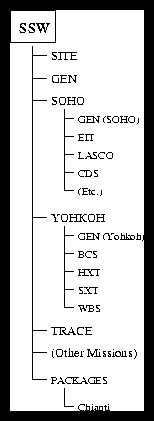
S. L. Freeland (freeland@sag.spasci.com)
Lockheed-Martin Palo Alto Advanced Technology Center
Palo Alto, CA 94303
B. N. Handy
Department of Physics
Montana State University-Bozeman
Bozeman, MT 59717
The SolarSoftWare System (SSW) originally evolved from the Solar Maximum Mission and the Yohkoh Software data analysis system. The Yohkoh team required a software package to manage the data products generated by the Soft X-ray Telescope (SXT), the Hard X-ray Telescope (HXT), the Bragg Crystal Spectrometer (BCS) and the Wide-band Spectrometer (WBS). (see Ogawara et al. (1991) for a summary of the Yohkoh mission.) The goal was a system capable of complete data management ranging from level-zero reformatting to data analysis and presentation, providing a common environment for data analysis for all the experiments (Morrison et al., 1991).
The Yohkoh Software system has since been expanded and generalized to work with experiments on the Solar and Heliospheric Observatory (SOHO), including the Extreme-ultraviolet Imaging Telescope (EIT), the Michelsen Doppler Imager (MDI), the Coronal Diagnostic Spectrometer (CDS) and the Large Angle Spectroscopic Coronagraph (LASCO) (see Domingo, Fleck, & Poland (1995) for a description of the SOHO mission). The success and growth of the SSW system is the result of collaboration between the science teams of the various Yohkoh instruments, the SOHO mission and ground-based observatories.
The system will run on any Unix and VMS based platforms supported by IDL, and has been successfully run on PCs running FreeBSD and Linux. Installation and setup are largely transparent on different platforms. The SSW system includes startup scripts which may be configured to support local variables in system setup, such as location of ancillary databases (a mixture of ground-based and satellite-based databases may be present on the system), paths to local binary executables and location of the SSW tree itself. This configuration of database management facilitates coordinated data analysis between different experiments.
The SSW system works with IDL data structures as specified in the Yohkoh system, and also with the SOHO FITS standard. The SSW system reads FITS headers into an IDL structure for further analysis, and non-standard FITS keywords can be easily accommodated with specialized FITS reading routines. Regeneration of legacy FITS files is unnecessary. Few restrictions are imposed on data files by IDL, as there is no unique IDL or SSW file format.
The SSW system includes routines to assist in software maintenance and allow for user-contributed software. Users may submit routines for inclusion in the master tree and these routines are automatically checked for conflicts with the system. The SSW system also has routines to update the software tree on the user's system via the Internet, and only those routines which have been updated or added since the last upgrade are downloaded from the master site. Online documentation is available for most of the SSW tools.

A typical (though extensive) setup is suggested in figure 1. At installation time a site may select which missions and experiments are required for data analysis. Each mission will have a generic directory with tools common to that mission, plus specialized directories for instruments associated with that mission. It is not necessary to include all instruments for a particular mission. It is possible to include other packages in this directory structure. The Chianti code, presented as an example here, is an atomic database of emission lines in UV and EUV wavelengths (Dere et al., 1998). Other packages are available.
Installation assumes IDL is already installed on the host system. Installation of the SSW system is usually accomplished over the internet, though other arrangements are possible when this option is not feasible. The user selects desired instruments and databases from an HTML form, which then creates (again via the SSW system) a shell script the user executes on the client machine. This script checks for dependencies and required disk space, then downloads the requested libraries and databases via FTP. The user is directed to the SSW web site1 for current information and web-based forms for web-based installation.
1 http://www.lmsal.com/solarsoft/